Little Things Lost
I’m old enough to have forgotten a lot of things, but also old enough to remember a lot of things that no longer exist, and that, in fact, seem either quaint or even borderline incredible, today. But cumulatively, I think, they can be used to reconstruct a way of life that has mostly vanished, at least some of which should be missed.
Downtowns
There was a time when each town or city in the United States boasted a downtown area unique to that place, identifiable at a glance to any native. To describe the downtown I knew best – Wichita Kansas in the 40s and 50s – in those days, in a relatively small city of about 150,000 people, we had one mega-department store (The George Innes Company) taking up half a city block and several stories tall, several smaller department stores (Bucks, Hinkels, Walkers, Penney’s, Sears – the last two, familiar ones, relatively minor players in the mix), dozens of specialty clothiers, haberdashers, milliners, furriers, jewelers, half a dozen movie theaters including two cinema palaces – the Orpheum and the Miller; three premier hotels (the Lassen, the Allis, the Broadview) plus a dozen smaller ones; a public library, a convention center, city hall, county courthouse, central post office, two railroad stations, and a host of other places of business, plus a major wholesaling and manufacturing district, all in less than a square mile of closely built land centered on 120-foot-wide Douglas Avenue. And it was served by 24-hour bus lines that networked it to every corner of the city.
By the 1970s a pair of cookie cutter suburban malls identical to a thousand others all over the country, full of chain store outlets, had completed the work of sucking all the major retail business out of the town center. Now the downtown remaining is a shell of its former self, most of the stores gone along with the theaters and restaurants, the habitat mostly of office workers and a few places where they can catch a fast lunch. This story has been repeated a thousand times around the country, to the ultimate loss of our sense of place.
Douglas Avenue, Wichita, in the 1950's
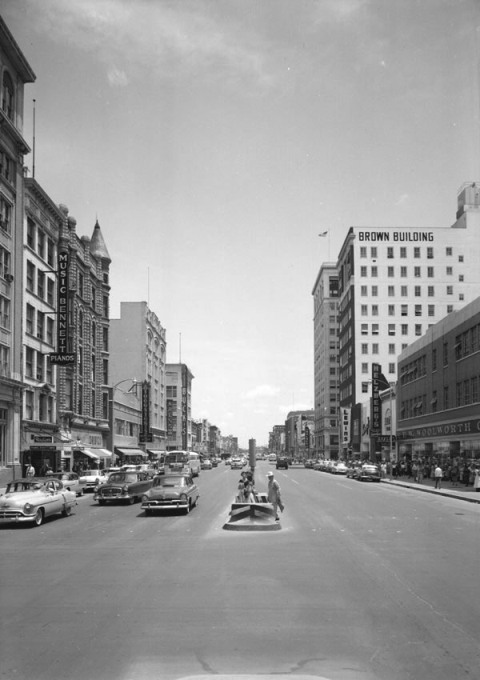
|
The Neighborhood Drugstore
When I was a kid in south Wichita, the hub of my immediate neighborhood was McCauley’s Drugstore on the corner of my block. There was no place just like it anywhere else in the world, although it was a typical independent neighborhood pharmacy. Owned by old Mrs. McCauley, the widow of the pharmacist who had established it in the 1920s, the store had plate glass windows facing Harry Street (the neighborhood thoroughfare), a blank brick wall on the side next to Washington Street (on which I lived, six houses down the block) that in later years always boasted a big sign advertising Muehlbach Beer (the Kansas City brew) and inside the cool, high-ceilinged interior a counter with a soda fountain and several tall wire-legged stools for customers. There I could order a nickel ice cream cone (hand-dipped), buy a 10-cent comic book, or purchase a variety of other useful goods (hence the alternate name “sundries store” for this type of enterprise). Mrs. McCauley was a neighbor of ours; my best friend was her grandson Roger; her daughter clerked in the store and her son was away at college learning to be a pharmacist just like his dad had been.
Today I’m sure the entire neighborhood, just like millions of other Americans, treks to an area Walgreens or CVS – each one pretty much like all the others around the country. A vastly better, bigger stock of goods to choose from, no doubt; and the service probably just as good. But the heart has gone. The former McCauley’s store site is now an empty asphalt slab providing parking for a few cars next to a pawn shop.
old drugstore interior
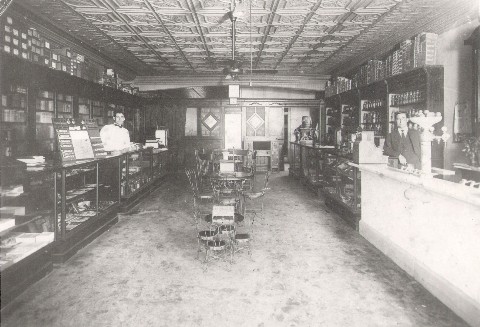
|
Saturday Matinee Movie Theaters
Every Saturday afternoon for many years all the kids in our part of Wichita who could cadge fifty cents from their parents were drawn like flies by maple syrup to the Southern Theater at the corner of Harry Street and Topeka. For several decades the Southern was the matinee theater for all south end Wichita. For our fifty cents we could buy a ticket plus a bag of popcorn; and the ticket would get us a double feature of western movies (Hopalong Cassidy, Roy Rogers, Rex Allen, and a cavalcade of other stars) plus a cartoon, a newsreel, and the latest episode of a cliffhanging serial such as Rocket Man.
All that came rapidly to a halt with the advent of TV, which provided a free alternative without our having to trek the half mile or more from home to the Southern and face the sticky floors and mob of noisy kids. A brief fling at being reborn as an “art theater” didn’t work out for the Southern. The building was heavily remodeled in recent years into a VFW hall and is unrecognizable except for the bit of steps and concrete walk that used to face the lobby entrance.
Southern Theater at night
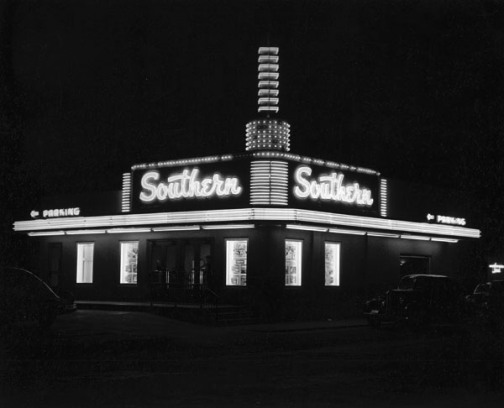
|
Safe Neighborhoods
Up until some point about 30 years ago most urban neighborhoods outside the biggest of cities were considered “safe” places for kids to grow up. Yards were open; streets were lined for miles by sturdy concrete (or brick) sidewalks for pedestrian traffic. Kids who weren’t in school or at church were expected to run around and play with each other until suppertime or bedtime, even after dark, with nothing to worry about more than “you’ll put your eye out” stuff. Parents for the most part didn’t worry unless there was major screaming or visible damage. There were no TV sets or computer screens or electronic games to mesmerize by the hour. We got exercise the old-fashioned way – by getting outside and using our legs for transportation, our arms for sports.
Now, sadly, in most towns children are guarded like sheep from wolves, kept inside or at the least in a tightly fenced yard, watched closely at shopping malls, schooled in buildings with security systems. Besides the easy, natural exercise, something else very fundamental has gone missing from our children’s lives – the sense that they live in a safe world. We likely can never retrieve that.
“Indian camp” in a neighbor’s backyard, 1940s
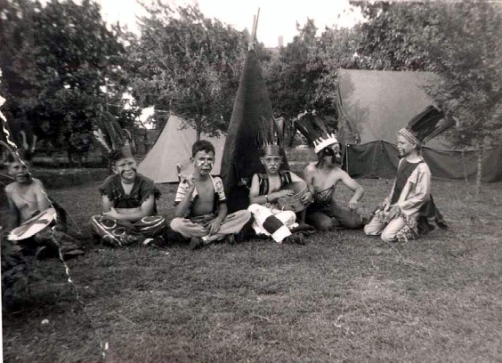
|
Family Meals
When I was a kid in the 1940s and 1950s, we ate breakfast at 7:00, lunch at noon, supper at 6:00 p.m. Together, sitting around our little kitchen table. You could set a clock by our mealtimes. And we talked, even if just about the food and whether my brother had gotten a bigger serving than I did. (Never happened – Mom used a micrometer to measure portions.) And this was the normal thing for families all over the country, unless something untoward, like night shift work, prevented it. A saying used to go “A family that eats together stays together.” People truly believed that. The beginning of the end of family mealtimes probably was the advent, not of television, but of “TV dinners” – the now ubiquitous pre-packaged frozen meals that relieved homemakers of so much tedious work, but also “freed” families from the necessity of sitting together at a table so their lovingly prepared meals could be served efficiently from the adjacent stove and countertop.
And the invention of microwave ovens pretty much drove the last nail in the coffin, as they made meal preparation accessible to even little kids, so long as they could pop open the door, shove in the frozen food, and push a couple of buttons. How many of us know families where the parents and the children scarcely see each other face-to-face all day long? How many of us are families like that?
Blair family with friends around a dinner table
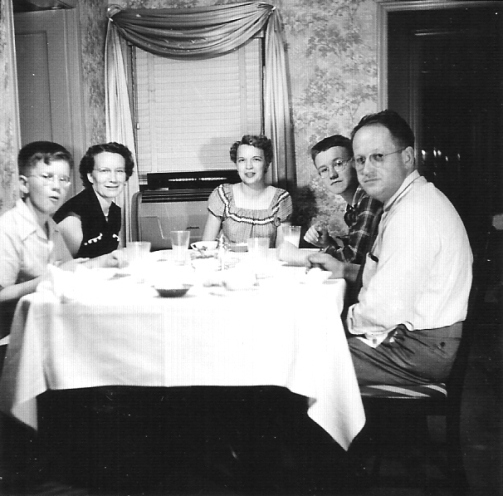
|
Sunday Drives
Gasoline used to be cheap. No, really. Just a few cents a gallon. That lasted pretty much until the 1970s. People took casual drives for recreation, cars were big, and for many American families the Sunday drive, including the entire family, was an institution. It was for us. Our custom was to eat just two (big) meals on Sunday – a substantial breakfast, and a mid-afternoon Sunday dinner that often featured fried chicken. After dinner, to relax and get a much-needed change of scene after a week of office or store or factory (for Dad), of kitchen and laundry and mending and housecleaning (for Mom), of school and homework and backyard (for us kids), we would all pile into our Ford (we were Ford people – never Chevrolets; and Chrysler products were not in the picture) for a leisurely drive out into the country. We had a choice in 1940s Wichita, Kansas, of driving south into the orchard and truck garden district of the sandy Arkansas River valley, west across flat wheatfields dotted by tiny German Catholic communities with steepled churches, north into Mennonite country around Newton, or east into the rolling pastures of the nearby Kansas Flint Hills – our favorite direction. Sometimes we’d take the Sunday papers with us and we kids would read the funnies while Dad stopped by the roadside to pick wild fruit for Mom to use in making jam or jelly. It was family time, fun time, genuine re-creational time that restored our souls in some essential way.
It’s been years since I’ve heard of families doing this. Too many “must-see” TV shows, computer games, Facebook, Twitter, marathon cell phoning, etc. And gasoline for which a bank loan seems appropriate.
Blair brothers with their Dad,
ready for a Sunday drive in their 1941 Ford
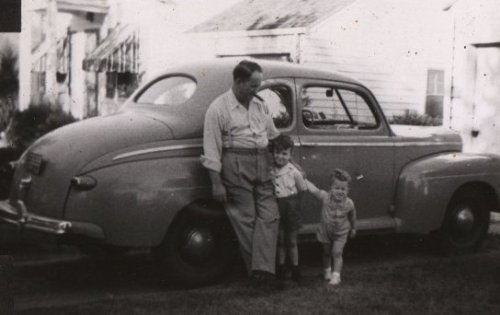
|
Homemade Toys
For generations now, toys have come in fancy boxes, from stores or delivered by UPS or Fedex to the door. Most are made in Asia, of plastic. It wasn’t always that way. During World War II plastic essentially didn’t exist yet, and metal was strictly rationed. Old sets of lead soldiers, metal toy cars, cap pistols, and tricycles vanished rapidly into the war machine, melted down for the all-out effort to defeat the Axis. Store-bought toys were painted wood, paper mache, cloth or cardboard. My first toy farm set was all punch-out poster board figures, very fragile. But we never lacked for toys, because we made our own, using a heavy dose of imagination and ingenuity. Instead of lead soldiers I used wooden domino sets and bags of glass marbles, just “imagineering” them into uniformed men. I was fortunate enough to have a Dad with woodworking tools and supplies of wood from which, with his help at first, my brother and I armed ourselves to the teeth with cut-out pistols, rifles, even a tommy gun! The acme of our arsenal was a tripod-mounted heavy machine gun.
John and Charlie Blair, ready for battle
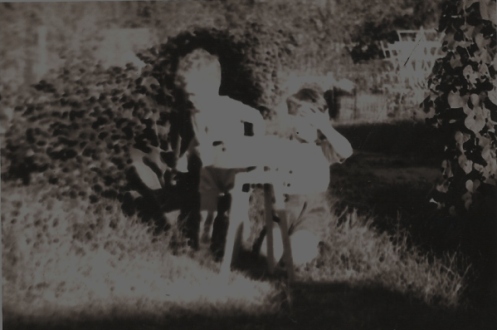
|
We supplied the entire block for simulated warfare using nothing but scrap wood, a band saw, and a few nails for triggers. Of course the sound effects were oral, each kid vying with the others for the best explosive noises, usually with lots of spit involved. After war rationing ended in 1945, store-bought cap pistols gradually entered the mix; but the homemade wooden guns still had their firepower honored, especially when the wielder had a particularly convincing mouth noise to accompany his weapon.
There are many other memories I could add of little things now lost; but the message is the same for all of them. Whatever the flaws of those days – and they were legion, ranging from race prejudice to (relatively) primitive health care to such monsters in the room as WWII and genocide – families had a tighter bond, children were called on to use their imagination and entertain themselves, home life at least felt more secure for most people, and communities were held together by feelings of unique locality and a powerful sense of place. We’ve traded much of that for convenience, speed, technology, variety, instant gratification. And not all of that is bad, by any means. But we should recognize the losses, in the hope that we can limit future losses a bit and perhaps not quite lose everything we valued in those days.
©2012 John I. Blair






No comments:
Post a Comment